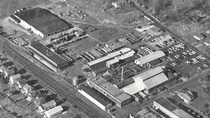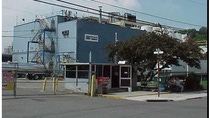Media
BASF gives former industrial sites a rebirth, thanks to environmental remediation

In a small town just outside of Philadelphia you’ll find Ambler Yards, a commercial park that’s home to a range of businesses catering to 21st-century tastes, including a taproom, a gourmet coffee shop and “1776,” a co-working space named in honor of the region’s pivotal role in the American Revolution.
About 90 miles from Ambler Yards, in Hoboken, New Jersey, construction on one of the nation’s first “resiliency parks” is underway. Along with providing recreation, the 5-acre Northwest Resiliency Park is designed with a retention basin and other features to absorb excess stormwater runoff, alleviating the flooding that often plagues the densely populated city, where about 53,000 people live in an area of just over a square mile.
At first glance the two sites might seem to have little in common. But in fact, both share some key attributes—for starters, the Ambler and Hoboken properties are former industrial sites that until recently belonged to or were controlled by BASF. Also, with assistance from the company and other stakeholders, the two properties have been repurposed following environmental remediation by the German company.
For decades, predecessor companies to BASF made products ranging from pesticides to metal treatments at the 44-acre Ambler site. In Hoboken, the Henkel plant was originally owned by Standard Chemical. It was built by Standard near the Hudson River docks on swamps that were filled in the late 1800’s. Standard and Henkel manufactured chemicals for nearly 80 years, until operations ceased in the mid-2000s. BASF acquired both properties in 2010, when it purchased Cognis (which until 2001 was a division of Henkel).
Years of industrial activity left both sites contaminated, said Edward Vanyo, a BASF Remediation Project Manager who has helped oversee the cleanup at Hoboken and Ambler for several years.
.jpg)
BEFORE
(Ambler site, 1950s)
The remediation process partly involved treating multiple underground storage tanks and associated contaminated soil, and treating impacted groundwater.

AFTER
Ambler Yards, which opened in the Fall under a 99-year lease with BASF, is now “a beehive of activity," according to Ed Vanyo, BASF Remediation Project Manager. (Credit: Ambler Yards Renderings)
Each site presented challenges, Vanyo explained. “In Ambler, the remediation process—which began in the 1980s—partly involved removing or treating multiple underground storage tanks and associated contaminated soil, and treating impacted groundwater, a difficult task given the then active operations and the area’s complex geology.”
“We also focused on being protective of the health and safety of the people who occupy the site and the surrounding community,” Vanyo said.
While groundwater monitoring continues, remediation at Ambler is now effectively complete. Ambler Yards, which opened in the Fall under a 99-year lease with BASF, is now “a beehive of activity,” Vanyo added.
But it took several years to get to that point. The process is complex and can take a great deal of time.
“There’s an investigative phase, followed by significant monitoring of the soil and groundwater conditions. These sites were impacted over the course of 50 or 60 years, and our goal was to clean up the area using the most effective remediation practices and return them to beneficial use for the communities,” he said.
.jpg)
BEFORE
(Hoboken building early 2000s)
The Henkel plant was originally owned by Standard Chemical. Standard and Henkel manufactured chemicals for nearly 80 years, until operations ceased in the mid-2000s.
.jpg)
AFTER
In addition to the retention basin and other flood-control measures, Northwest Resiliency Park, in Hoboken, will boast a skating rink, an athletic field, a pavilion and playground equipment. (Artist rendering: City of Hoboken)
Back in Hoboken, meanwhile, the City of Hoboken continues the construction of the park. In addition to the retention basin and other flood-control measures, Northwest Resiliency Park will boast a skating rink, an athletic field, a pavilion and playground equipment. It’s scheduled to be completed in about three years, city officials told news site NJ.com.
BASF purchased the closed and vacant site from Cognis in 2010 and conducted no manufacturing under its ownership before selling it to the city of Hoboken in 2016. First, though, the company remediated contaminants in the soil and installed a protective asphalt cap over the remediated area in accordance with applicable regulatory guidelines.
BASF played a critical role in preparing for the transformation of the Hoboken site, as well as in Ambler. But Vanyo is quick to point out that many stakeholders helped with both projects, including the Ambler Yards developers, local government leaders, environmental officials and members of the public.
“This has definitely been a collaborative effort,” Vanyo concluded.
Published on February 26, 2020 by BASF staff writers.
For media inquiries or to repurpose this article, please contact Lisa Brown.